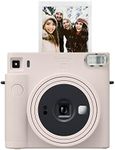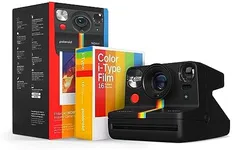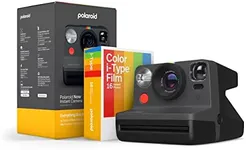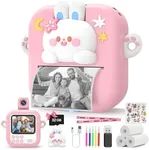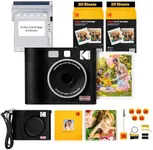Buying Guide for the Best Instant Film Cameras
Instant film cameras are a fun and nostalgic way to capture moments and have physical photos in your hands within minutes. When choosing an instant film camera, it's important to consider several key specifications to ensure you get the best fit for your needs. These specs will help you understand the camera's capabilities and how they align with your photography preferences.Film FormatThe film format refers to the size and type of film the camera uses. This is important because it affects the size of your photos and the availability of film. Common formats include mini, square, and wide. Mini film is small and portable, great for casual snapshots. Square film offers a classic look and is slightly larger, making it ideal for more detailed shots. Wide film provides the largest prints, perfect for group photos or landscapes. Choose a format based on the type of photos you want to take and how you plan to use them.
Lens QualityThe lens quality determines the sharpness and clarity of your photos. A higher quality lens will produce clearer and more detailed images. Lenses can range from simple plastic to high-quality glass. Plastic lenses are more affordable and suitable for casual use, while glass lenses offer better image quality and are ideal for those who want more professional-looking photos. Consider how important image quality is to you when selecting a lens.
Exposure ControlExposure control allows you to adjust the brightness of your photos. This is important for getting the right lighting in different environments. Some cameras have automatic exposure settings, which are great for beginners as they adjust the settings for you. Others offer manual controls, giving you more creative freedom to adjust the exposure based on your preferences. If you enjoy experimenting with different lighting conditions, look for a camera with manual exposure control.
FlashThe flash is used to illuminate your subject in low-light conditions. A built-in flash is common in instant film cameras and is essential for indoor or nighttime photography. Some cameras have an automatic flash that adjusts based on the lighting, while others allow you to manually control the flash. If you plan to take a lot of photos in low light, make sure the camera has a reliable flash. For more control over your lighting, look for a camera with manual flash settings.
Battery TypeThe battery type affects how you power your camera and how often you need to replace or recharge it. Instant film cameras can use disposable batteries, rechargeable batteries, or built-in rechargeable batteries. Disposable batteries are convenient for occasional use but can be costly over time. Rechargeable batteries are more eco-friendly and cost-effective if you use the camera frequently. Built-in rechargeable batteries are convenient but require access to a power source for recharging. Consider how often you will use the camera and your preference for battery maintenance when choosing.
Size and PortabilityThe size and portability of the camera determine how easy it is to carry around. Smaller, more compact cameras are great for travel and everyday use, while larger cameras may offer more features but can be bulkier to carry. Think about how you plan to use the camera and whether you need something that fits easily in a bag or pocket. If you want a camera that's always with you, opt for a more portable model.
Additional FeaturesAdditional features can enhance your photography experience. These might include selfie mirrors, tripod mounts, multiple exposure modes, or creative shooting modes. Selfie mirrors help you take better self-portraits, while tripod mounts provide stability for long exposures or group shots. Multiple exposure modes allow you to combine two images into one, and creative shooting modes can add fun effects to your photos. Consider which features are important to you and how they align with your photography style.




